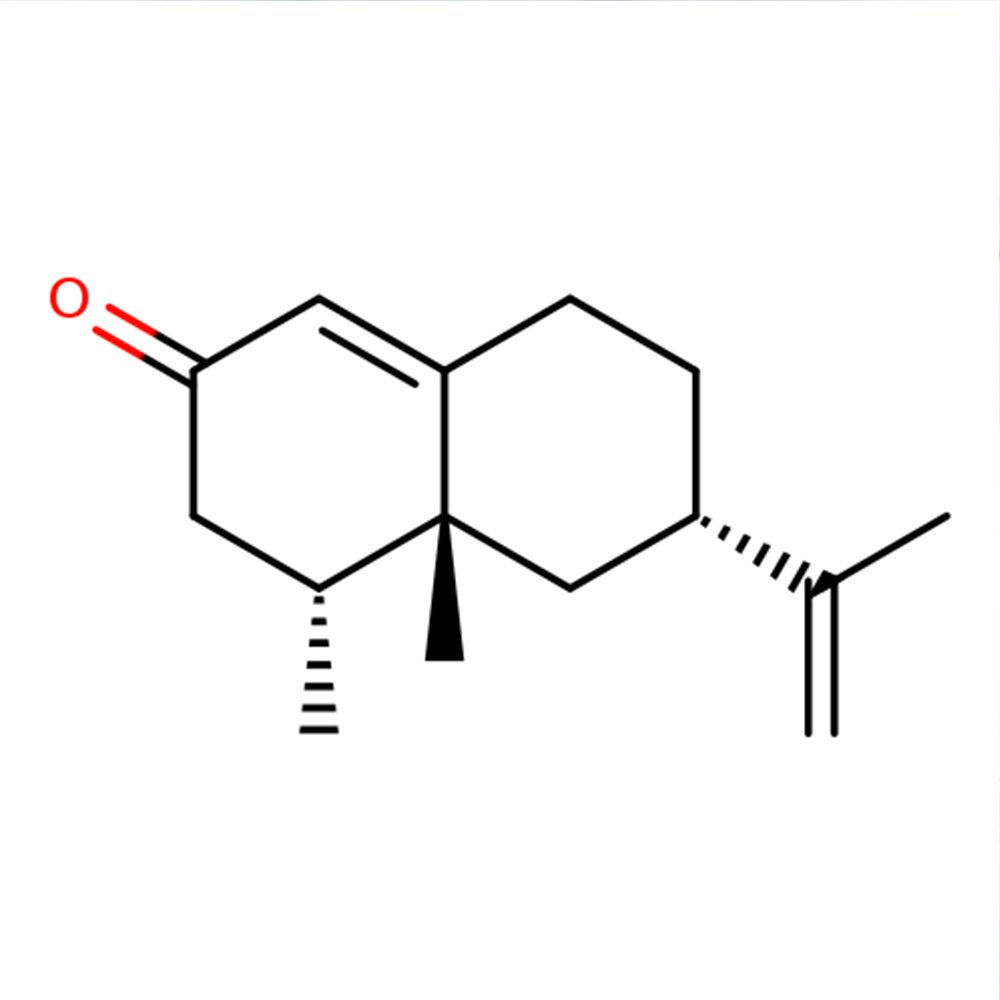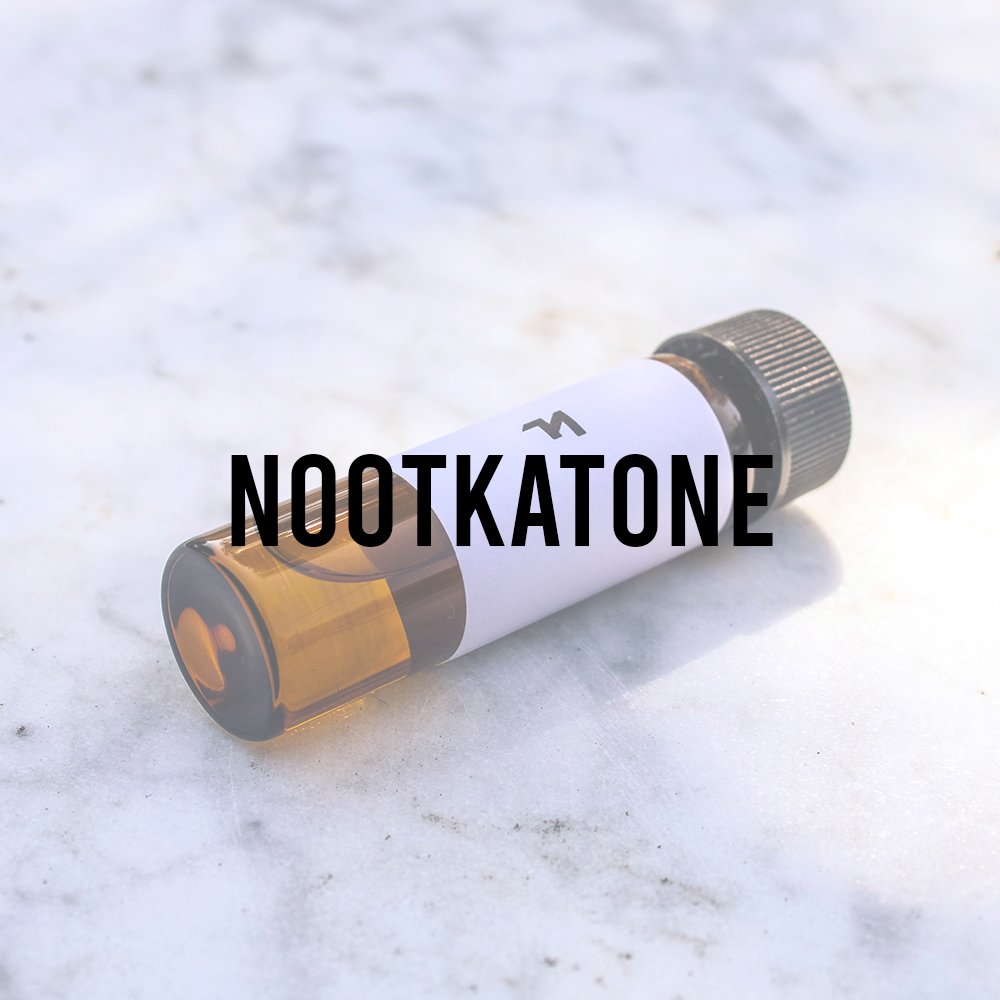Synthetic Ingredient Overview
🏭 Manufacturer: Evolva, IFF, other biotech or flavor houses
🔎 IUPAC Name: 4,4a,5,6,7,8-hexahydro-3,6,8,8-tetramethyl-1(2H)-naphthalenone
🧪 Synonyms: (+)-Nootkatone, 1(10)-Aromadendren-9(10)-one
🧬 Chemical Formula: C₁₅H₂₂O
📂 CAS N°: 4674-50-4
📘 FEMA: 3166
⚖️ Molecular Weight: 218.33 g/mol
📝 Odor Type: Zesty–Citrus
📈 Odor Strength: Very high (odor threshold ≈ 800 ppb)
👃🏼 Odor Profile: Powerful grapefruit peel, zesty citrus, woody, vetiver, green, earthy, herbal, tobacco-like
👅 Flavor Profile: Grapefruit-like at 0.1–0.3 ppm; perceptible in beverages at 0.3 ppm; bitterness increases above 50 ppm
⚗️ Primary Uses: Citrus enhancement, grapefruit reconstructions, woody-vetiver profiles, tropical-tobacco modifiers
🧴 Appearance: Almost colorless to pale yellow oily liquid (orange-tinted in commercial grades)
What is Nootkatone?
Nootkatone is a bicyclic conjugated sesquiterpene ketone. Though it occurs naturally in grapefruit peel oil (≈ 0.3%), its commercial form is produced synthetically via oxidation of valencene, a terpene extracted from orange juice oil. The process typically involves oxidizing agents such as tertiary-butyl chromate, or modern bioconversion pathwaysusing engineered enzymes. These processes yield a high-purity, cost-effective source of nootkatone that is widely used in fragrance, flavor, and pest control.
Nootkatone's structural class places it in the oxygenated sesquiterpenes, making it stable, tenacious, and potent at low concentrations.
Olfactory Profile & Perfumery Applications
👃🏼 Odor Characteristics:
Zesty and fresh, with dominant grapefruit peel and citrus top notes. Background impressions of woody vetiver, green-earthy tobacco, and mild herbal sharpness. It provides lift, realism, and persistence in citrus accords and modern fruity fragrances.
⚗️ Functional Roles in Formulation:
Top-note enhancer in grapefruit, bergamot, and bitter orange compositions
Adds depth to vetiver, green, and earthy bases
Blends effectively with hexenyl esters, aldehydes, citrus oils, woody materials
Used in modern fougères, ozonic-fruity colognes, and tropical accords
Subtle contributor to gunpowder, tobacco, or aromatic smoky facets
🧴 Compatible with:
Bergamot oil, hexyl acetate, hexenyl butyrate, ambrettolide, isobornyl acetate, limettal, aldehyde C12 MNA
Industrial & Technical Uses
Nootkatone is approved for broad use beyond perfumery, including:
Flavor industry: Grapefruit flavor in beverages, confections, gums (FEMA 3166)
Insect repellency: Proven efficacy against ticks, mosquitoes, bed bugs, lice
Environmental sustainability: Volatile, biodegradable, non-persistent
Pharmaceutical & cosmetic use: Low dermal toxicity, permitted in personal care
🔬 Production Notes:
Extracted valencene from orange peel oil (≤ 0.4%)
Oxidized chemically (e.g., CrO₃, oxygen + metal salts) or via enzyme fermentation (Evolva patented process)
Bioconversion routes allow for "natural" classification under some regulatory schemes
Regulatory & Safety Overview
IFRA: Not restricted under current IFRA 51st Amendment; recommended to follow general terpene ketone guidelines
EU Allergens: Not listed among the 26 declarable allergens
FEMA GRAS: FEMA 3166 – recognized as safe for flavor use in foods
ECHA (REACH): Registered; not classified as hazardous under CLP
Toxicology:
No sensitization, genotoxicity, or phototoxicity in standard testing
Low oral and dermal toxicity
Not classified as PBT or vPvB
Readily biodegradable
✅ Considered safe and sustainable for perfumery, flavor, insect repellent, and environmental applications under current regulatory frameworks.
Sources
Perfume and Flavor Chemicals – Steffen Arctander
The Nootkatones – John C. Leffingwell, Ph.D.
Flavors and Fragrance Chemistry, Bioprocessing and Sustainability
Flavor, Fragrance, and Odor Analysis
A Fragrant Introduction to Terpenoid Chemistry – Charles S. Sell
PubChem CID 1268142 – National Center for Biotechnology Information
CDC & Evolva – Nootkatone insect repellent licensing data












